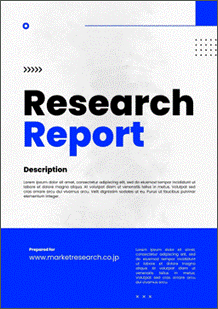 | • レポートコード:MRC2304G037 • 出版社/出版日:Mordor Intelligence / 2023年2月 • レポート形態:英文、PDF、100ページ • 納品方法:Eメール(受注後2-3営業日) • 産業分類:食品 |
| Single User | ¥665,000 (USD4,750) | ▷ お問い合わせ |
| Corporate License | ¥1,225,000 (USD8,750) | ▷ お問い合わせ |
• お支払方法:銀行振込(納品後、ご請求書送付)
レポート概要
| Mordor Intelligence社の市場調査レポートによると、世界の栄養強化剤市場規模が予測期間中(2023年-2028年)にCAGR 10.3%拡大すると見られています。本レポートでは、栄養強化剤の世界市場を調査対象とし、イントロダクション、調査手法、エグゼクティブサマリー、市場動向、種類別(タンパク質・アミノ酸、ビタミン、脂質、プレバイオティクス・プロバイオティクス、その他)分析、用途別(乳児用調製粉乳、乳製品・乳製品関連製品、シリアル・シリアル関連製品、飲料、その他)分析、地域別(アメリカ、カナダ、メキシコ、イギリス、ドイツ、フランス、ロシア、イタリア、スペイン、インド、中国、日本、オーストラリア、ブラジル、アルゼンチン、南アフリカ、サウジアラビア)分析、競争状況、市場機会・将来動向、新型コロナウイルス感染症の影響などを整理しました。並びに、市場調査の対象企業には、Cargill Incorporated、BASF SE、DuPont、Eastman Chemical Company、International Flavors & Fragrances Inc. IFF、Kemin Industries, Inc.、DSM、Kalsec Inc.、Archer Daniels Midland Company、Advanced Organic Materials, S.A.などが含まれています。 ・イントロダクション ・調査手法 ・エグゼクティブサマリー ・市場動向 ・世界の栄養強化剤市場規模:種類別 - タンパク質・アミノ酸の市場規模 - ビタミンの市場規模 - 脂質の市場規模 - プレバイオティクス・プロバイオティクスの市場規模 - その他栄養強化剤の市場規模 ・世界の栄養強化剤市場規模:用途別 - 乳児用調製粉乳における市場規模 - 乳製品・乳製品関連製品における市場規模 - シリアル・シリアル関連製品における市場規模 - 飲料における市場規模 - その他用途における市場規模 ・世界の栄養強化剤市場規模:地域別 - 北米の栄養強化剤市場規模 アメリカの栄養強化剤市場規模 カナダの栄養強化剤市場規模 メキシコの栄養強化剤市場規模 … - ヨーロッパの栄養強化剤市場規模 イギリスの栄養強化剤市場規模 ドイツの栄養強化剤市場規模 フランスの栄養強化剤市場規模 … - アジア太平洋の栄養強化剤市場規模 インドの栄養強化剤市場規模 中国の栄養強化剤市場規模 日本の栄養強化剤市場規模 … - 南米/中東の栄養強化剤市場規模 ブラジルの栄養強化剤市場規模 アルゼンチンの栄養強化剤市場規模 南アフリカの栄養強化剤市場規模 … ・競争状況 ・市場機会・将来動向 ・新型コロナウイルス感染症の影響 |
The global fortifying agents market is projected to register a CAGR of 10.3% during the forecast period (2023 – 2028).
The outbreak of COVID-19 has a significant impact on fortifying agents due to the increased consciousness of consumers in selecting food. This inclination towards sustainable, regenerative, plant-based nutrition and demand for foods and beverages with immunity-boosting ingredients is driving the demand for these products and their constituents. In addition to focusing on widening applications and introducing new product portfolios, most food and beverage companies are planning to capture domestic and international markets.
The market is mainly driven by the increase in the growth of the health consciousness of consumers. The support of government organizations has also fueled the market growth. For instance, the Food and Agricultural Organization (FAO) and the World Health Organization (WHO) have recognized food fortification as one of the key strategies to reduce widespread malnutrition, particularly in underdeveloped countries.
Fortification of wheat and maize flour with zinc, iron, folic acid, and other micronutrients has proven to be effective against iron deficiency anemia (IDA). Milk fortification helps in recovering the micronutrients that are lost during the processing of milk. Micronutrient content can be increased through the fortification process. This is also increasing the market demand.
Fortifying Agent Market Trends
Rising Consumption of Vitamin-infused Foods & Beverages
The demand for fortified foods and beverages market was witnessed to have an increasing trend owing to the rising health consciousness among the consumers and vitamin deficiencies which can cause health maladies such as anemia, scurvy, beriberi, and pellagra, to name a few. Also, studies have mentioned that these are not simply deficiency diseases but rather conditions that are present in a relatively well-nourished society. Therefore, food fortification with vitamins was proven an effective tool for tackling nutritional deficiencies among the population; but today, a more reasonable approach is to use food fortification as a means to support but not replace dietary improvement strategies (i.e., nutritional education campaigns). Furthermore, frequent launches of newly formulated products with modified blends of vitamins are likely to fuel the growth of the market, such as Alpha mind Vitamin-Infused Coffee, Snap Super Candy (vitamin-infused snacks), vitamin-infused water, and vitamin D fortified milk.
Asia-Pacific is the Fastest Growing Region
The Asia-Pacific region is predicted to be the fastest-growing market in the forecasted period. The growth of the market is quite less in the African region. In South Africa, multiple fortifications of biscuits with iron, β-carotene, and iodine improved the status of all of these nutrients in school children. Countries of the Asia-Pacific region, such as China and India, have the majority of the market due to their increasing disposable income, urbanized population, and expansion of key companies like Cargill, Incorporated and FMC Corporation in many countries. In China, a series of studies have been conducted to assess the efficacy, effectiveness, and feasibility of fortifying soy sauce with iron content.
Fortifying Agent Market Competitor Analysis
The global market for food fortifying agents is highly competitive, owing to the presence of large regional and domestic players in different countries. Some of the major players in this market include Cargill Incorporated, International Flavors & Fragrances Inc. IFF, DSM, Eastman Chemical Company, Kalsec Inc., DuPont, Archer Daniels Midland Company, DuPont, BASF SE, and Advanced Organic Materials S.A. are giving emphasis on the merger, expansion, acquisition, and partnership of the companies along with new product development as strategic approaches adopted by the leading companies to boost their brand presence among consumers.
Additional Benefits:
- The market estimate (ME) sheet in Excel format
- 3 months of analyst support
1 INTRODUCTION
1.1 Study Assumptions & Market Definition
1.2 Scope of the Study
2 RESEARCH METHODOLOGY
3 EXECUTIVE SUMMARY
4 MARKET DYNAMICS
4.1 Market Drivers
4.2 Market Restraints
4.3 Porter’s Five Forces Analysis
4.3.1 Threat of New Entrants
4.3.2 Bargaining Power of Buyers/Consumers
4.3.3 Bargaining Power of Suppliers
4.3.4 Threat of Substitute Products
4.3.5 Intensity of Competitive Rivalry
5 MARKET SEGMENTATION
5.1 By Type
5.1.1 Proteins & amino acids
5.1.2 Vitamins
5.1.3 Lipids
5.1.4 Prebiotics & probiotics
5.1.5 Carbohydrates
5.1.6 Minerals
5.1.7 Others
5.2 By Application
5.2.1 Infant formula
5.2.2 Dairy & Dairy-Based Products
5.2.3 Cereals & cereal-based products
5.2.4 Fats & oils
5.2.5 Beverages
5.2.6 Dietary supplements
5.2.7 Others
5.3 Geography
5.3.1 North America
5.3.1.1 United States
5.3.1.2 Canada
5.3.1.3 Mexico
5.3.1.4 Rest of North America
5.3.2 Europe
5.3.2.1 United Kingdom
5.3.2.2 Germany
5.3.2.3 France
5.3.2.4 Russia
5.3.2.5 Italy
5.3.2.6 Spain
5.3.2.7 Rest of Europe
5.3.3 Asia-Pacific
5.3.3.1 India
5.3.3.2 China
5.3.3.3 Japan
5.3.3.4 Australia
5.3.3.5 Rest of Asia-Pacific
5.3.4 South America
5.3.4.1 Brazil
5.3.4.2 Argentina
5.3.4.3 Rest of South America
5.3.5 Middle-East
5.3.5.1 South Africa
5.3.5.2 Saudi Arabia
5.3.5.3 Rest of Middle-East
6 COMPETITIVE LANDSCAPE
6.1 Most Active Companies
6.2 Most Adopted Strategies
6.3 Market Position Analysis
6.4 Company Profiles
6.4.1 Cargill Incorporated
6.4.2 BASF SE
6.4.3 DuPont
6.4.4 Eastman Chemical Company
6.4.5 International Flavors & Fragrances Inc. IFF
6.4.6 Kemin Industries, Inc.
6.4.7 DSM
6.4.8 Kalsec Inc.
6.4.9 Archer Daniels Midland Company
6.4.10 Advanced Organic Materials, S.A.
7 MARKET OPPORTUNITIES AND FUTURE TRENDS
8 IMPACT OF COVID-19 ON THE MARKET
